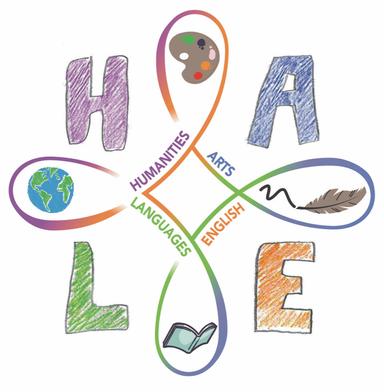

The HALE Journal Summer 2025
Celebrating academic excellence through competition entries

Welcome to the summer edition of the HALE Journal!
Inside, you'll discover outstanding examples of academic writing submitted by students from across the school as part of our external essay competitions, showcasing a diverse range of HALE subjects. This edition also features write-ups from several exciting trips and experiences our students have enjoyed this term. We hope you find this collection both inspiring and enjoyable—thank you for reading

To what extent should the law intervene in personal autonomy? By Amelia (L6) - This entry was Highly Commended for the Minds Underground Law essay competition
Personal autonomy: ‘ a person ' s sense of self-determination, of being able to make choices regarding the direction of [their] own actions, including the freedom to pursue those choices’ (Encyclopedia com, n d ) One could argue that this is a fundamental human right and that in a democratic society every person should have their human rights upheld. Alternatively, one could argue that even if they restrict personal autonomy, laws must be imposed to protect individuals and society. In deciding where to stand on this issue, one must acknowledge that both arguments are valid and true Therefore, my belief is that the law should intervene when individual choices cause direct and measurable physical, mental, or emotional harm to others but should respect personal autonomy when the consequences are limited to the individual. In this essay, I will evaluate the extent at which we should draw the line for an action to cause excessive harm and must be prevented by law.
In 1951, the United Kingdom ratified the European Convention on Human Rights (ECHR), evidencing its commitment to ensuring that all individuals in the country would have their personal liberties upheld Article 8: Right to respect for private and family life is significant, as it states that ‘There shall be no interference by a public authority with the exercise of this right except such as is in accordance with the law and is necessary in a democratic society [for] national security, public safety or the economic well-being of the country’ (European Court of Human Rights, n d ) However, in individual cases, it is difficult to establish when is ‘necessary’ and if the laws go too far, or even far enough. So, to consider this with a real-life perspective, I will analyse several debates surrounding personal autonomy and the law. The National Health Service defines euthanasia as ‘the act of deliberately ending a person’s life to relieve suffering.’ It has the maximum punishment of life imprisonment, while under the 1961 Suicide Act, assisted suicide can be punished by up to 14 years’ imprisonment. However, the debate over assisted dying is becoming increasingly controversial as on the 25th of March 2025, the Isle of Man became the first of the British Isles to approve an Assisted Dying Bill. There are disadvantages to this, including: vulnerable patients feeling pressured to die; contradiction with religious beliefs; and the possibility of new treatments or cures emerging in the future. However, it is undeniable that there are currently 982,000 people living with dementia in the United Kingdom (Alzheimer’s Society, 2024) Dementia and many other incurable illnesses, such as motor neurone disease and terminal cancer, can cause physical pain for the patient, which additionally can cause mental suffering for them and their loved ones. Relieving suffering through assisted dying could alleviate some of that pain for people with irreversible and degenerative health conditions, where quality of life and progress is poor. Therefore, my belief is that this is a case when the law should partially intervene in personal autonomy because the harm caused by assisted dying is overshadowed by that of continuous suffering. What I mean by this is that there should be legislation to legalise assisted dying and to simplify the process where thresholds are met (however, there should be strict criteria for this to be approved).
This should include that the person is terminally ill, have given their full consent and are mentally competent to make the decision. This is essential to refute the ‘slippery slope’ argument, which suggests that ‘if voluntary euthanasia were to be [legalised], it would not be long before involuntary euthanasia would happen’ (BBC, 2010)
Another debate over personal autonomy, which is particularly prevalent as we emerge from the COVID-19 period, is compulsory vaccinations. In the United Kingdom, vaccines are strongly encouraged by the Department of Health and Social Care alongside the National Health Service, but they are not enforced Should the government take a more hard-line approach towards vaccines? This has been implemented by other European nations, such as France, which since 2018, has imposed 11 compulsory vaccines for babies and children, including Hepatitis B and DTP (diphtheria, tetanus, and poliomyelitis). If a child has not been vaccinated, they will not be accepted into any community of children, such as daycare or school (Service-Public.fr, n.d.), which ensures that the parents’ decision will not negatively impact any other children. I would propose that in the cases of severely dangerous diseases, unless a person is exempt from vaccination due to weakened immune system or other valid reason, the government should use legal incentives to encourage people to have vaccinations – such as access to certain public services including schools. My reasoning for this is primarily the scientific concept of herd immunity, defined by the World Health Organisation as ‘the indirect protection from an infectious disease that happens when a population is immune through vaccination,’ which demonstrates that if individuals have a vaccine administered, it will positively benefit public safety. Furthermore, legal intervention is necessary in cases regarding children, as they are unable to make informed consent for themselves, so the child’s safety – and the safety of other children due to herd immunity – lies in the hands of their parents. I acknowledge that compulsory vaccinations would undermine bodily autonomy, an important human right. However, the mention of ‘interference...is...necessary...in the interests of...public safety’ in Article 8 of the ECHR is applicable in the case of vaccines (European Court of Human Rights, n.d.), highlighting the fact that an individual’s human rights must sometimes be sacrificed for the welfare of others Another criticism is that compulsory vaccinations could potentially lead to further enforced medical treatments in the future, which would violate Article 3 of the ECHR - Prohibition of torture (European Court of Human Rights, n.d.). While this is a valid concern, it could be partially combatted by the absence of physical coercion to enforce the vaccine, as restriction to public services are an example of a soft mandate (Law Insider, n.d.).
The final topic I will consider is the battle between freedom of expression and hate speech. Article 10 of the ECHR states that ‘ everyone [has] the freedom to hold opinions and to receive and impart information and ideas without interference by public authority’ but this can be ‘subject to restrictions’ for a list of exemptions, which include ‘the protection of the reputation or rights of others’; ‘the prevention of disorder or crime’; and ‘the protection of health or morals’ (European Court of Human Rights, n d ) However, the Equality Act 2010 makes it illegal to discriminate against a person because of ‘protected characteristics’: age, gender reassignment, being married or in a civil partnership, being pregnant, disability, race, religion, sex, and sexual orientation (UK Government, n.d.). This makes it complicated to establish the boundary between free speech and discrimination The exact wording of the legislation must be carefully considered, as there is a significant difference between the verbs ‘to hold,’ meaning ‘to have an opinion’ and ‘to impart,’ meaning ‘to make information known to someone’ (Cambridge Dictionary, n.d.). I believe that if a person has a certain opinion, and it is only they who know about said opinion, legal intervention would be unnecessary because this opinion is not causing harm to others. However, it is when that opinion is imparted onto others that legal intervention is needed as this can cause negative emotional or mental health effects for the person to whom the opinion is being imparted or for the person or group of people the opinion concerns. Although government restrictions on offensive speech could be seen as a form of censorship and oppression of individual voices, it is important to note that these voices can have real-world disastrous consequences if they are not managed by law. One example is how, if unregulated, social media platforms can form a breeding ground for hate speech and abuse. For instance, as part of its ‘Toxic Twitter’ initiative, a 2017 poll by Amnesty International concluded that 23% of the women surveyed ‘had experienced online abuse or harassment at least once’ (Amnesty International, 2018).
In conclusion, while personal autonomy is a basic human right in a democratic society, it can never be absolute because if this were to happen, it would cause complete anarchy. The law should intervene when a person’s actions can be significantly harmful to others – by which I mean the physical, mental, or emotional effects will last for more than several hours. That said, in cases where the effects are limited to the individual, legal intervention should be prevented This follows the belief of ‘The Harm Principle,’ the creation of which is credited to English philosopher John Stuart Mill. ‘In ‘On Liberty,’ John Stuart Mill famously argued that “the only purpose for which power can be exercised over any member of a civilised community, against his will, is to prevent harm to others”’ (Holtung, 2002). I conclude that while some personal autonomy is necessary, it is equally necessary that it is regulated by legal legislation to protect the wider human rights of society.
Bibliography:
· Alzheimer’s Society (2024) How many people have dementia in the UK? https://www.alzheimers.org.uk/blog/how-many-people-have-dementia-uk (Accessed: 1 April 2025).
· Amnesty International. (2018) Online violence against women – Chapter 3.2. https://www.amnesty.org/en/latest/news/2018/03/online-violence-against-women-chapter-3-2/ (Accessed: 31 March 2025)
BBC. (2010) Slippery slope arguments in euthanasia debate. https://www.bbc.co.uk/ethics/introduction/slipperyslope.shtml (Accessed: 31 March 2025).
· Cambridge Dictionary. (n.d.) Hold. https://dictionary.cambridge.org/dictionary/english/hold (Accessed: 31 March 2025)
· Cambridge Dictionary. (n.d.) Impart. https://dictionary.cambridge.org/dictionary/english/impart (Accessed: 31 March 2025).
· Encyclopedia.com. (n.d.) Personal autonomy. https://www.encyclopedia.com/socialsciences/encyclopedias-almanacs-transcripts-and-maps/personal-autonomy (Accessed: 30 March 2025).
· European Court of Human Rights. (n.d.) European Convention on Human Rights. https://www echr coe int/documents/d/echr/Convention ENG (Accessed: 30 March 2025) Gov.uk. (n.d.) Discrimination: your rights. https://www.gov.uk/discrimination-your-rights (Accessed: 31 March 2025).
· Holtung, N. (2002) ‘The Harm Principle’, Ethical Theory and Moral Practice, Vol.5, No.4, pp 357-389 https://www jstor org/stable/27504250 (Accessed: 30 March 2025) Law Insider. (n.d.) Soft mandate definition. https://www.lawinsider.com/dictionary/softmandate (Accessed: 31 March 2025).
· NHS. (2022) Euthanasia and assisted suicide. https://www.nhs.uk/conditions/euthanasia-andassisted-suicide (Accessed: 31 March 2025).
· Service-Public.fr. (n.d.) Childhood vaccinations. https://www.servicepublic.fr/particuliers/vosdroits/F767?lang=en (Accessed: 31 March 2025).
· World Health Organization (n d ) Herd immunity https://www who int/news-room/questionsand-answers/item/herd-immunity-how-can-we-achieve-it (Accessed: 31 March 2025).

Hannah (L6) secured 3 place in the AHA (Art History Abroad) Trenchard Cox Scholarship with these essays, for which pupils had to write 400 words on a work they LOVE and 400 on a work they LOATHE! She did super well: a competitive field of over 60 entries!
Nancy Holt’s Sun Tunnels are an enigmatic work of art that, despite my scepticism on certain land art, have a magnetic and irresistible draw that compels me to visit. At first glance, the distinctive man-made arrangement seems almost harsh, invasive, and out of place in the vast Utah desert However, when you think more beyond their striking minimalism, there lies a profound meditation on time, space, and our place in the universe. Entering one of the tunnels allows you to step into a carved-out fragment of the landscape, introducing a clarity of focus as the vast space around you shrinks to a circular exit with a small, concentrated view of the mountains that surround the colossal desert. Their presence frames and articulates the landscape, transforming our perception of vastness. What I love most about the Sun Tunnels is that they exude a sense of serenity yet curiosity, an invitation to be in the moment, to focus with clarity, and then let the mind drift. I imagine standing among them, feeling the hush of the desert, my mind at first pausing in awe, and then subsequently wandering as I contemplate their steadfast and unchanging nature amongst a constantly shifting environment. Circular perforations in the concrete act as a mirror of constellations, casting shifting patterns of light that change throughout the day. I can visualise the glow from the constellations filtering through the orifices, and I imagine it almost as if ribbons of light are falling from the stars to loop through the carefully curated apertures. One can witness the choreography of sunlight, moonlight, and starlight dance across the interiors forming ever-changing patterns, creating a story of light and time told through shadows and illumination. The harnessing of the movements of the sun, stars, and planets ground us in our own existence, encouraging us to think about our relationship to the earth beneath us and the sky above, and in relation, providing a highly unusual conception of eternity, a concept that becomes both tangible and deeply poetic. The Sun Tunnels stand as both art and environment, with the somewhat strange objects simply existing as a unit in a landscape shaped by geological history, with little mark of Man Their durability and sustainability allow them to exist largely undisturbed, requiring minimal conservation. And yet, they are more than static objects; they are an essay, a film, a series of drawings and photographs, a gathering of possibilities. I hold endless admiration for the endless forms of creativity that can and have blossomed from this artwork, sparking inspiration with those who fall in love with it, influencing them to create, to feel, to perceive, to wonder, and to explore.
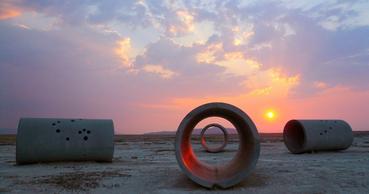
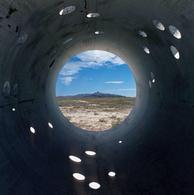
Richard Long’s A Line Made by Walking is often hailed as a seminal piece in the Land Art movement, but for me, it falls flat both visually and conceptually. While it might be deeply personal to Long, referencing his connection to walking, nature, and childhood, this intimacy is entirely lost to me and my own love for walking in the beautiful British countryside. The photograph is in black and white, stripping away the vibrant greens, fiery autumn reds, and earthy browns that make the British landscape so compelling. What’s left is a grey and bleak image that drains the life out of the scene My eyes are drawn in by the line but are then halted when they reach a dark mass that blocks any longitudinal view, a trail which leads to nowhere, offering no reward, no revelation. My eyes glaze over it. As a connection to nature, I find little striking about it, nothing that sparks curiosity or wonder My conception of land art is often about the pilgrimage; the experience of being there, of interacting with the art and the landscape. Artists like Nancy Holt or Agnes Denes created work that encourages immersion and awe. Long’s work, in contrast, is a photograph of a concept, or a temporary mark in the land. Ultimately the art is the photo, and thus, there is no experience to be gained. It’s easily replicable, and without physical presence, its value becomes highly questionable. There’s also a hypocritical edge to Long’s philosophy He claims not to want to mark the land, yet in other works he moves rocks and rearranges nature. A Line Made by Walking feels to me like selfish art, made for him, not for us. Perhaps if I hadn’t grown up seeing these same lines across English fields every rainy Sunday walk, I’d find it novel But the feeling experienced from this artwork is not nostalgia Instead, the cropped view and dark masses evoke feelings of constriction and entrapment, not like the openness and endlessness of the British countryside that I find peace and serenity in walking through. It reminds me not of peaceful rambling through open fields, but of bleak factory yards and industrial-era photos. If this is a love letter to nature, it’s written in grey ink and sealed with silence.

How might global migration patterns change by 2050 due to environmental factors? Amisha’s (L6) entry for the Minds Underground essay competition
As one views the global migration patterns today, it is clear that the environmental causes are predominantly ‘climate-induced migration’- the concept describing the movement of people due to life-threatening environmental changes (Migration Policy Institute, 2023). As climate change forecasts to worsen, global migration patterns will inevitably face changes by 2050; areas become inhabitable following rising sea levels, desertification and extreme weather events. This environmental hostility induces emigration, further causing economic and political tensions. Despite this, it can be argued that it is possible for global responses to regulate and reduce this global migration if successful policies are implemented to protect the livelihoods of climate victims.
THE IMPACT OF RISING SEA LEVELS
It is clear that the environmental drivers of migration all result from the damaging effects of climate change. One such effect is rising sea levels, causing mass coastal displacement. Scientists project that “Global mean sea levels will rise almost 1 foot above 2000 levels by 2050” (NRDC, 2024). An inevitable consequence of this is devastating flooding. It is forecasted that if we continue down our current path, “by 2050, up to $106 billion worth of coastal property globally will be below sea level” (EPA, n.d.). As global warming exacerbates (due to the trapped greenhouse gases in the atmosphere), glacial ice melts “at an average rate of 150 billion tonnes per year” (NASA, 2025). This leads to a greater water discharge, which exceeds the maximum volume capacity for the body of water, subsequently flooding lowlying coastal areas and destroying homes, farmland and critical infrastructure. This eventually collapses the local economy and rapidly drives inhabitants out As climate change worsens this process, it is conceivable that global migration patterns will face changes as people relocate from high-risk areas to unaffected regions. Some highly vulnerable countries, such as Bangladesh, where 28% of the population lives in coastal zone areas (ScienceDirect, 2023) will likely face the highest levels of forced coastal emigration by 2050- likely to urban centres or neighbouring countries such as India. It has been projected that “if sea levels rise by 1m by 2050, approximately 18% of Bangladesh's land area will be submerged” (ScienceDirect, 2023). This imposes a catastrophic threat to people’s livelihoods with a loss of homes and agriculture, forcing them to relocate to inland cities such as Dhaka. This will mean a large population increase in Dhaka, adding to the existing 4 million slum inhabitants (Ahmed et al., 2023). Additionally, a damaging consequence of flooding is saltwater intrusion (rising sea level mixes saltwater into freshwater sources). In a region where “ many people's livelihoods depend on climatesensitive industries such as agriculture” (ScienceDirect, 2023), this process means soils will render infertile and drinking water from natural sources (predominantly used by those in poverty) becomes contaminated. As food and water security declines, the rate of emigration intensifies. This pattern will be seen globally, affecting all coastal regions with a low-lying topography as they face similar migration consequences.
While likely migration patterns suggest a population decline in coastal zone areas, this rate of emigration can be reduced by 2050 through increased provisions of “water-resistant construction materials and salt-resistant crops” (LSE Grantham Institute, 2023) to try protecting agricultural productivity and homes. Furthermore, it is possible to limit the devastating impact of the flooding through increased coordination between government bodies and NGOs For example, in Bangladesh, this has already allowed for the planting of Mangroves which protect “1.11 million people and US$1.56 billion in property” (Bamber et al.,2020)- reducing the impact of rising sea levels. This coordination would allow for faster response, especially in remote regions and also to assist in areas of health and education such as restarting schools after a flood (LSE Grantham Institute, 2023). These improvements to flood management could limit the threat posed to civilians and so decrease the amount of outmigration by 2050- meaning the population decline from coastal areas is not as high as forecasted Despite this, the reduction in migration is dependent on government willingness in flood- affected countries to cooperate and implement these measures. Without this, expeditious rates of migration are likely.
THE IMPACT OF DESERTIFICATION
By 2050, desertification is forecasted to be one of the greatest drivers of migration. The UN describes it as a “ process of land degradation in arid, semi-arid and dry sub-humid areas” (Iberdrola, n.d.). A range of environmental factors such as rising atmospheric temperatures and droughts exacerbate this process. These factors are heavily influenced by global warming which “alters rainfall and makes drought more frequent” (Enel Green Power, 2024). This has detrimental consequences on agricultural productivity- not only reducing subsistence farming but also destabilising incomes for those who rely on selling crops. This was seen in Niger where droughts caused a “12% decline in cereal production from 2019-2020” (Vision of Humanity, 2023), significantly impacting farmers’ profits. This incentivises the departure of farmers to areas of soil prosperity As global warming forecasts to worsen, reaching 2 5ºC above preindustrial levels by 2050 (Earth Charts, n.d.), it is viable to predict that these impacts on crops will worsen, dramatically increasing the need for people to migrate to areas with greater food security. Additionally, a survey conducted by the British Red Cross in North Africa concluded that many respondents had “difficulty accessing healthcare due to reduced household income” (following a shortage of crops sold) (ODI, 2020), proving the economic challenges of desertification. As a result, people are forced to migrate due to this limited economic opportunity and a reduced standard of living

Arguably, migration patterns may not face immense change by 2050 due to the effectiveness of governments in mitigating the impacts of desertification. Government initiatives such as the ‘Great Green Wall’ (reforestation project spanning 8000km along the Sahel), aims to restore 100 million hectares of degraded land, preserving fertile land for agriculture (UNEP, 2022). The success of this project would allow for greater food security, protecting the soil from encroaching desertification (Earth.org, 2023). By improving the conditions, it is possible that migration patterns in this region don’t change very much by 2050 if strategies are successful. However, the success of the project depends on funding and management of the afforestation as it could introduce invasive species that hinder agricultural revenue. Therefore, while initiatives can provide benefits, paucity of funding and upkeep can hinder them, harming locals and leading to emigration from areas facing desertification.
THE IMPACT OF EXTREME WEATHER EVENTS
In recent years, there has been a global surge in extreme weather events such as hurricanes, cyclones and typhoons following a rise in global temperatures. Climate change increases ocean temperatures, providing more energy for tropical storms and increasing their destructive power (EDF, 2023). Due to climate change, it is likely these events will further intensify by 2050. Countries such as the Philippines, Bangladesh are often the most affected, experiencing mass displacement and long-term damage. These storms are one of the largest causes of climate refugees, defined as “ persons displaced in the context of disasters and climate change” (UNHCR, 2022). These disasters often destroy homes, livelihoods and infrastructure, usually making returning back impossible. This was seen with Typhoon Haiyan which struck the Philippines in 2013, destroying 90% of Tacloban City and other parts of the country (SEI, 2023). As a result, over 4 million people were forced to move to resettlement sites within the Philippines and in Malaysia (SEI, 2023). According to a study, by 2050, around 13.5 million people will be exposed to cyclone- induced storm surges (World Bank, 2019), forcing migration. As these events are forecasted to have even more intensity, it is likely that outward- migration to unaffected regions will increase by 2050 Estimation suggests that “there will be as many as 1 2 billion climate migrants by 2050” (Migration Policy Institute, 2021). Consequentially, the pressure caused by a sudden population rise could lead to political unrest in affected areas due to increased competition for jobs and resources. This growing pressure can fuel social unrest, forcing further movement of migrants or by influencing which areas are willing to accept these climate refugees- hence further impacting migration patterns.

To conclude, by 2050, global migration patterns are likely to be reshaped significantly by environmental factors, exacerbated by climate change. The continuation and increase in sea level rise, desertification and extreme weather events will lead to the displacement of millions, forcing them to leave vulnerable areas to places safe from these impacts. Not only do these environmental factors directly contribute to migration, they also play a significant role in resource availability, economic and political instability- influencing where people move to. Despite the use of NGOs and government policies to mitigate the impacts of these environmental factors, the success of these can vary, depending on factors such as funding and upkeep. Therefore, as environmental degradation continues to impact the shifting flows of people, one can expect global migration patterns to change immensely over the next 25 years, becoming one of the most significant issues affecting our planet by 2050.
BIBLIOGRAPHY
NRDC, n.d. Sea Level Rise 101. [online] NRDC. Available at: https://www.nrdc.org/stories/sealevel-rise-101 [Accessed 27 Feb. 2025]. NASA, n.d. Ice Sheets – Vital Signs of the Planet. [online] NASA Climate Change. Available at: https://climate.nasa.gov/vital-signs/ice-sheets/ [Accessed 27 Feb. 2025]. Haque, M.A., Rahman, M.M. and Uddin, M.N., 2023. Climate change induced migration and its impact on mental health: A study on Bangladesh Heliyon, 9(10), e21003 Available at: https://www.sciencedirect.com/science/article/pii/S2405844023053987 [Accessed 1 Apr. 2025]. World Bank, 2019. Coastal Resilience in Bangladesh: Protecting Coastal Communities from Tidal Flooding and Storm Surges. [online] Available at: https://www worldbank org/en/results/2019/09/10/coastal-resilience-in-bangladeshprotectingcoastal-communities-from-tidal-flooding-and-storm-surges [Accessed 1 Apr. 2025]. Iberdrola, n.d. What is desertification and how does it affect the environment? [online] Available at: https://www.iberdrola.com/sustainability/desertification [Accessed 1 Apr. 2025]. Enel Green Power, 2024. What is Desertification? [online] Available at: https://www.enelgreenpower.com/learninghub/gigawhat/searcharticles/articles/2024/06/desertification [Accessed 1 Apr. 2025]. ODI, 2020 Changing Climate, Changing Realities: Migration in the Sahel – Summary Report [pdf] London: ODI. Available at: https://media.odi.org/documents/Summary reportChanging Climate Changing Realities Migration in the Sahel.pdf [Accessed 2 Apr. 2025]. Mixed Migration Centre, 2021. The Impact of the Sahel Conflict on Cross-Border Movements. [pdf] Available at: https://mixedmigration.org/wpcontent/uploads/2021/10/192 the impact of the Sahel conflict on cross border m ovements.pdf [Accessed 2 Apr. 2025]. Vision of Humanity, 2023. Challenges Facing the Sahel: Climate, Conflict and Overpopulation. [online] Available at: https://www visionofhumanity org/challengesfacing-the-sahel-climate-conflict-andoverpopulation/ [Accessed 2 Apr. 2025].
Does Ancient Literature equate Might with Right?
By Claudia (L6)
Ancient literature often contains or is centred around themes of power and strength, whether of an individual, group or entire state. ‘Might’ in Ancient literature is a commonly discussed portrayal of power, often referring to military or political strength. ‘Right’ then can be viewed as an accepted morality or moral code promoted or engrained in the society of the text. Justice and lawful authority can also be depicted as the ‘right’ in a piece of literature, often condemning the wrongdoing done by individuals or state. However, Ancient literature often does equate the two, asserting that exertion of strength or power over others is morally correct and this often extends to violence being irreprehensible in particular cultures or situations. This can be particularly seen in works of epic such as the Aeneid and the Iliad, as well as some Greek Tragedies, where violence and political domination through warfare and piracy is expected, and largely not condemned. Nevertheless, some works critique this connection, such as in certain philosophical texts, yet the dominance of works emphasising this connection makes it overtly notable.
To begin with, Homeric epic can be used to exemplify the equating of might and right by ancient figures and societies. Power, physical strength and ability in battle is central to the Greek heroic ethos and ability of the hero to achieve kleos (long lasting glory). Achilles’ wrath and godly strength for example is central to the narrative and his violence and ‘might’ is morally justified in the pursuit of justice and most importantly, honour. For that matter, it is socially permissible for warriors in the Iliad to commit veritable massacres on either side of the conflict, even taunting their enemies and victims in the pursuit of justice in battle. Even Patroclus, a more benevolently presented warrior, mocks Cebriones for the “somersault” his body makes out of his chariot after being stabbed.
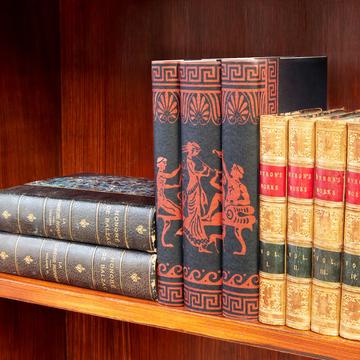
In contrast, Agamemnon utilises his political might to command the army, and while this is flawed and ultimately drives Achilles away, he holds the right to rule the army from his social power and position as “ man of the highest rank”. Hence, might in the Iliad is used to gain legitimacy in power, as well as honorific goods and geras (war prizes).
Many scholars, such as Simone Weil, even argue that ‘The true hero, the true subject, the centre of the Iliad is force’ -thus cementing continuous focus on violence as power. Moreover, this is often seen alongside divine support to various heroes which gives them power – such as Apollo to Hector. Their actions have righteous claim as they have been ordained by gods. Might and violence in vengeance is also a socially honoured action in the Odyssey, as Odysseus arguably rightfully punishes Penelope’s suitors for destroying his household, killing them all in the name of justice. This is even endorsed with a “thunderclap from Zeus” which illustrates that the divine powers are cheering his violence in battle and equate it with the ‘right’ course of action. Odysseus also exhibits piracy throughout the Odyssey, sacking cities such as Ismarus, the land of the Ciciones. Despite the consequences of this attack being a deadly retaliation from the native people when Odysseus’ men are “carried away by greed”, Odysseus continues to “slaughter menfolk” and “steal resources” unavenged, with the implication he was rightfully able to do so along his journey, fresh from the victory of war. Nevertheless, there are some instances of condemnation of excessive violence in Homeric epic, the most startling of which being the dragging of Hector’s body around Troy by Achilles. The Olympian gods, prompted by Apollo, take pity on Hector and condemn Achilles’ mutilation of his body. However, Homeric epic centres primarily on the winning and possession of godly, physical and social ‘might’ to rightfully exert power and thus it could convincingly be argued the two are equated.
In this vein, Virgil’s Aeneid could also be viewed as rightful justification for Rome’s military might and right to wield it to conquer. Aeneas embodies the figure of the justified conqueror, something taken on by the Roman people, especially by claiming the power of their city was divinely fated, a fact illustrated in the Aeneid. As Anchises (Aeneas’ father) says to him in the underworld “Roman, remember by your strength to rule Earth’s peoples for your arts are to be these: To pacify, to impose the rule of law, To spare the conquered, battle down the proud.” Though Virgil is arguing that the Roman desire to impose peace on its conquered people makes their rule justified, it is thus then morally justifying Roman invasion and ‘pacifying of other tribes’ in the name of bringing peace and lawfulness.
Indeed, Virgil also uses divine assent to legitimise Roman rule, the most prolific example being Jupiter’s proclamation that he has given the Romans “ power; empire without end”. This then overtly states Romans are eternally fated to exert their might and power on others without consequences – it is ‘right’ and expected to do so ‘ as Virgil uses Jupiter’s divine authority to justify the rise of the Roman Empire.’ The reasons behind writing the Aeneid also align with this view, as Virgil was commissioned by Augustus, not only give legitimacy to Augustus’ reign by writing himself into history, but to validate the constant state of warfare and outside siege that existed in Rome. By equating the might of Rome to the rightful path ordained by the Gods, he created an image of himself as not just a militarily successful leader, but a pious one too. Therefore, Virgil’s epic not only equates might with right but glorifies it, suggesting it is expected and encouraged by a higher power.
When it comes to Greek tragedy, the idea of might being morally justified is questioned more sceptically. In the Bacchae, the god Dionysus exerts what could be argued is his rightful revenge for being denied worship; he has King Pentheus brutally murdered at the hands of his own mother. However, this display of divine strength and fury is met with pleas of mercy from the people who have been destroyed; Pentheus’ grandfather Cadmus laments that Dionysus “punishes too severely”. Thus, while divine violence is somewhat expected as a form of revenge from a religious viewpoint, it is arguable that readers are not meant to find it morally correct, particularly concerning characters like Cadmus who are simply punished by association. Tyrannical rulers in tragedy are also often criticised for their destructive use of ‘might’ upon their citizens, such as the character of Oedipus in the latter half of Oedipus Rex when the messenger is ‘afraid to speak freely in front of the king’ for fear of his anger and punishment. Thus, Sophocles is here condemning Oedipus’ excessive fury and threats of violent might upon others, not providing moral justification for his actions. This almost exactly mirrors a scene in the Bacchae, where a messenger refuses to tell Pentheus about the activity of the Bacchants unless Pentheus can promise he will be free from harm. In this way, both playwrights are attacking kings’ and leaders’ unjust use of their power through social status.
More philosophical viewpoints found in works of Plato and Aristotle continue to question the morality of political and physical might as universally acceptable. In Plato’s Republic, for example, he argues that power and justice should be held not just through might, but brought by “fulfilment of one’s role in society”, such as through the hypothetical ‘philosopher king’ who rules with knowledge and wisdom rather than simply strength. However, wisdom could still be viewed as a form of power though intellect and therefore Plato still argues it is morally right for a knowledgeable ruler to exert control. It is here that philosophical paragons come into conflict with literature over depictions of rightful ‘might’, particularly when involving violence and domination. Ancient literature will often dismiss philosophical criticisms and move towards equating might with right when it is useful to portray an especially strong or powerful character, or during times of warfare and political expansion.
In conclusion, while there are occasions where the moral legitimacy of unchecked power is questioned, in most Ancient Literature the prevailing trend is that ‘might’ is justified and rightful. Often aided by divine assent to validate violent use of power in battle or politics, heroes and other powerful figures are usually glorified for their ability to remain strong over others, and thus rightfully claim honour and power. Examples such as the Aeneid and the Iliad prove that Ancient societal values embrace this use of might to be moral and correct and hence authors are able to write their characters in this way, embodying the rightful mighty hero.
Bibliography
Weil, S (1939) “The Iliad, or the poem of force” https://theanarchistlibrary.org/library/simone-weil-the-iliad
Warriors18672 (2016) “Virgil’s glorification of the Roman Empire” https://neilshah456.wordpress.com/2016/10/12/virgils-glorification-of-the-roman-empire/
The Iliad, Homer, translated by E V Rieu and updated by Peter Jones
The Odyssey, Homer, translated by E.V Rieu.
The Aeneid, Virgil, translated by David West
The Bacchae, Euripides, translated by Robin Robertson.
Oedipus Rex, Euripides, translated by David Grene

Eshaal’s (U4) Immerse essay competition entry

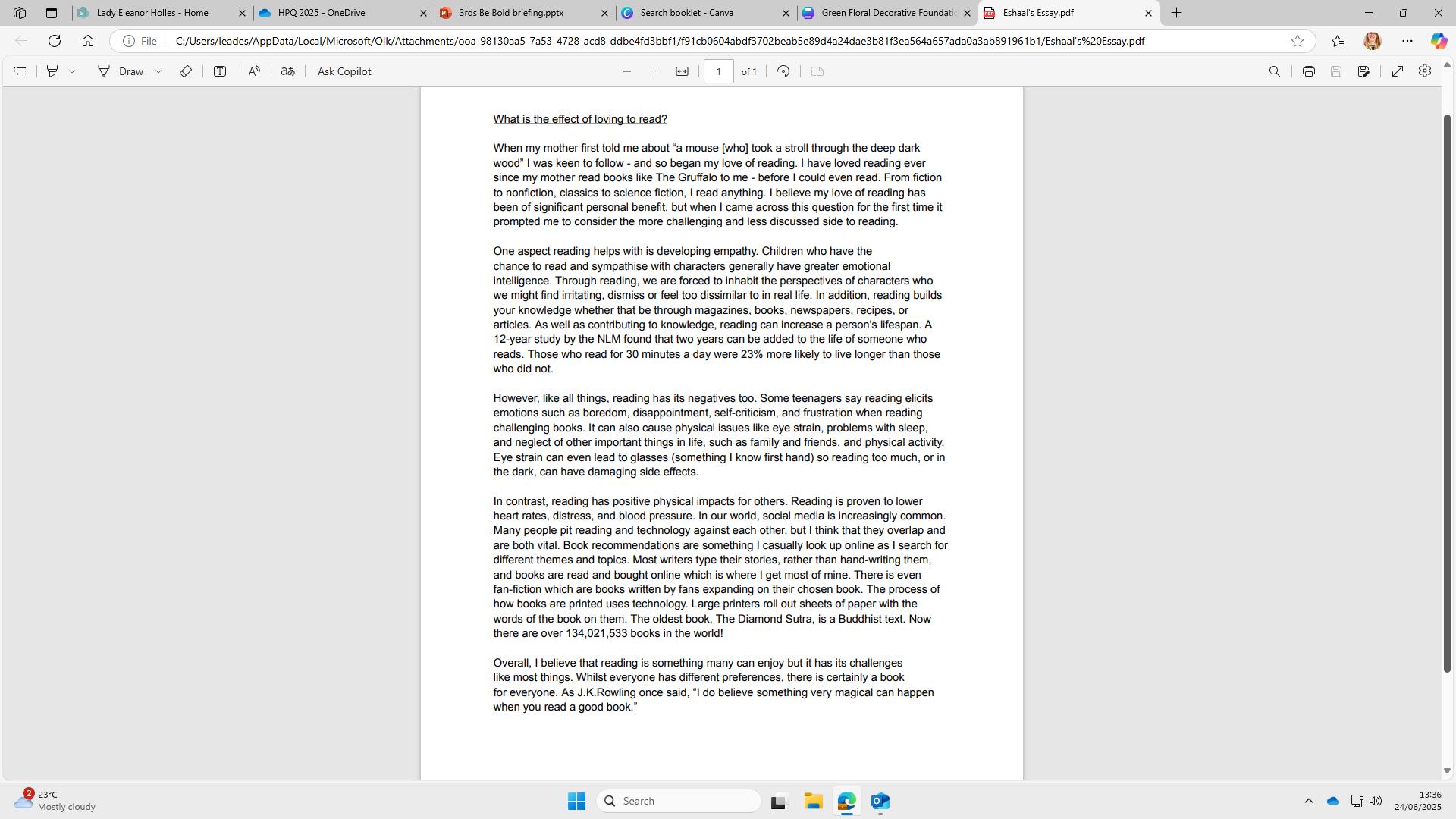
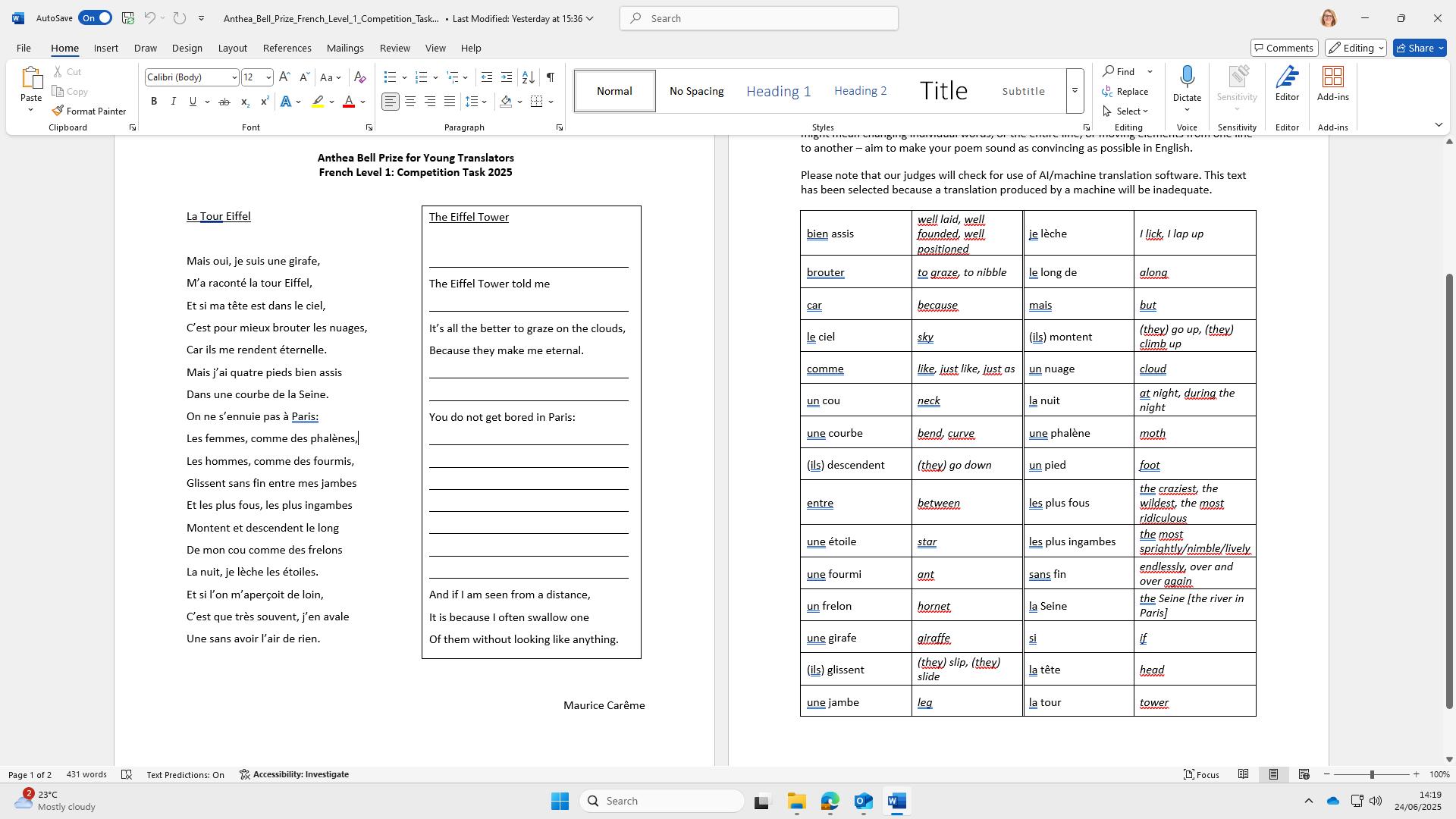
Vaanika (L4) was commended for her Level 1 Anthea Bell
Translation of the poem “La tour Eiffel” by Maurice Carême
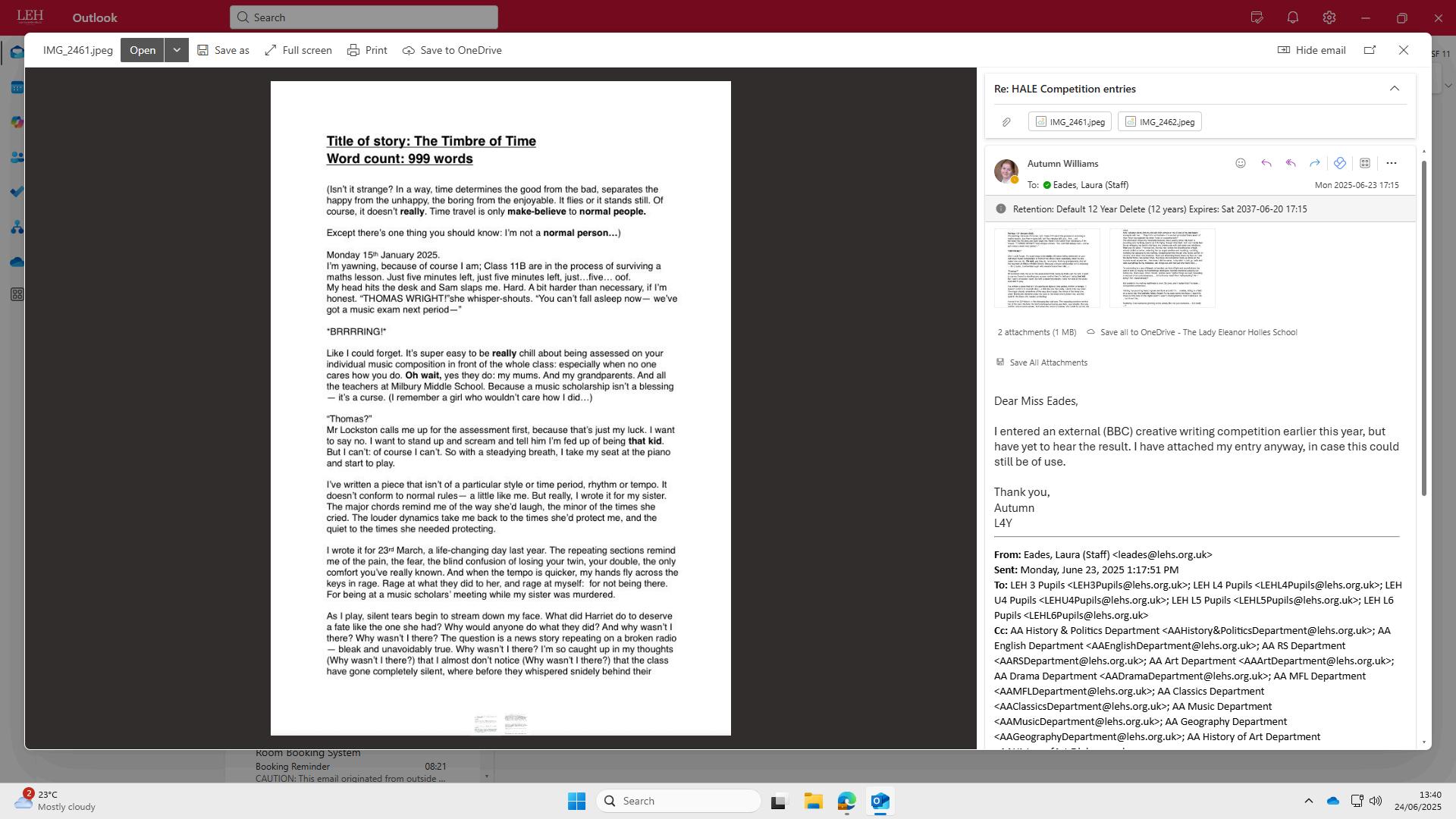

Alara (3rds) has won the Global Young Journalists Award 2025 for "best climate piece" in the Day Student Voices article
Is climate change becoming forgotten?
All these current wars and battles against humanity are unnatural occurrences that are not meant to happen; we are not evolved, adapted or meant to fight wars and commit murder, but we are meant to look after our planet, the Earth, the one thing we cannot make a duplicate of. From a religious standpoint, God made humans to look after and protect the world, and from an atheist perspective, humans are the most powerful and advanced species, so the Earth’s preservation is our responsibility. Our Earth is truly special and holds 8 billion of us, with no other planet capable of holding human life. Therefore, we must protect our only resort for life and as Greta Thunberg said, “there is no Planet B”.
All the current affairs, wars and new leaders are taking up the public’s attention, away from climate change and the urgent action that is needed.
We set a goal many years ago, not to go pass 1.5. Yet we did, but no one seems to care. Is passing that target we set many years ago thought as merely a reminder, and not as a warning from Mother Nature? Have we found a new planet, and if we did, will we just throw Earth away? Was our goal and target ever important? And if it was, why have we forgotten about the emerging crisis?
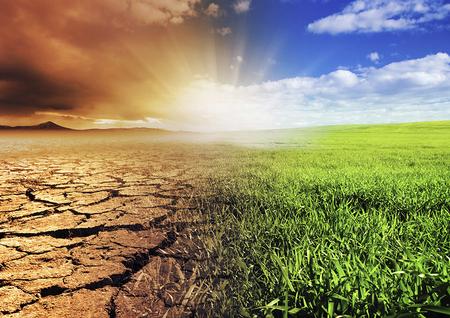
We need to do something and take responsibility. We need to own up to our mistakes. Is it simply insignificant now, the climate, the earth, our descendants being left in a dreadful situation, with Earth on the verge of being destroyed? Is it more important that a celebrity has broken up with their partner, or whether TikTok is banned, or if there is a new movie on Netflix? At the moment, it seems like nearly everything is more important than climate change and that is hard to believe, with human and every other organism’s extinction on the line.
Some people ask why others, like me, care about this issue?
Well I care because it is my generation that will be affected, not this current generation. All the other teenagers and I will grow up in an almost destroyed world, and instead of having successful careers we will all be needed to take care of the earth. Climate change is only getting worse, and at this rate all natural things will be completely gone, destroyed, all because of our irresponsible actions and failure to open our eyes to our surroundings. We must be accountable, as much as we try and change this.This is a fact. This is the truth. We couldn’t look after the earth successfully snd did the worst job so far. We need to own up to our mistakes and fix them, before it is too late. We must set a new state of mind towards climate change. We must take action now, not later. We must fix this now. We must stop this now.

L6 History of Art trip to London -
By Daisy
The L6 art Historians spent a delightful day out in London on Friday 27th June. When we first entered the newly opened V&A East Storehouse, we were met with a wide array of randomly dispersed unique pieces covering the 4-storey storehouse. Each level consisted of repeating shelves where we discovered separate masterpieces around every corner, and on the 3rd floor we even discovered a design by one of our specified architects, Frank Lloyd Wright, an office space that was designed for the 10th floor of the off for Kaufmann’s Department Store in Pittsburgh, Pennsylvania. We next ventured to the Aquatic Cent designed by another one of our specified architect Zaha Hadid. We circled the exterior and commented the continuous form, which was representative of flowing body of water, reflective of the pool on the interior. Next was our train ride to the National Galle y where we saw three portraits, including two striking Renaissance works by Raphael and Bellini as well as Henri Matisse’s portrait of Greta Moll, where he used experimental techniques and encouraged us to ask what was being portrayed: the sitter’s character and identity or the new identity of painting. We then wandered across the street and entered the National Portrait Gallery, where we met Charlotte Bolland, Senior Curator of the 16th century Collection, who offered us her insightful view upon the collection of the six wives of Henry VIII exhibition and answered our varied questions about the importance of constantly looking and potential pathways into art-related careers. Finally, we took a blustery and refreshing boat ride to the Tate Modern, where we saw Maman, the iconic 30ft steel and marble spider by Louse Bourgeois, which towered over us, providing a marvellous ending to the day.
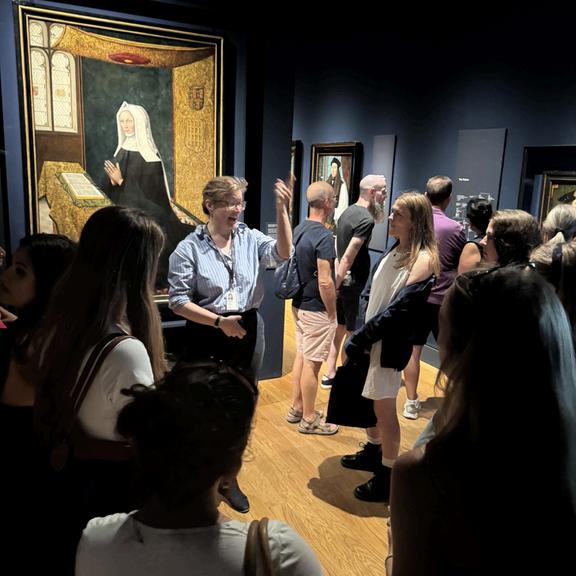



Members of the Historia Lectures club were fortunate to attend the British Library for an immersive investigation into sources from the Windrush generation. In the first portion of our trip to the British library we were given time to explore and take a look at the exhibition currently on display. This exhibition included some famous historical documents like the Magna Carta, a letter written by Jane Austen to her sister and several important religious texts like early versions of the Bible. We found it very exciting to be able to see these in person and even read parts of them, although many of them including the Magna Carta were written in Old English so were challenging for us to understand. It was very enjoyable as we discovered some of the intriguing challenges with studying primary texts. After this we wandered around the library, specifically looking at the Kings library in the centre of the building. A part we found incredibly interesting was looking at the 3D plan of the library as we didn't know that a large majority of the books were stored underground. It was also astonishing to see the sheer size of the storage spaces and the number of books they contained.
Following this, we all partook in a workshop learning how to analyse what sources say, as well as looking beyond the mere words and searching for more information from the emotions of voices in recordings and dates that sources were written. Our main focus for the workshop was the story of the Windrush generation and we were shown personal recounts and sources from members of the Windrush generation. We returned to the Treasures Gallery to find the actual sources on display and have a closer look. In particular, we enjoyed using oral history sources (tape recordings and interviews) as we found it really interesting to have the new experience of interacting with recordings as opposed to written sources. We all thoroughly enjoyed the trip and certainly left eager to return to the British Library very soon!




Our talented L4 linguists represented LEH at the Poetry Live Final, which took place at St Mary’s University Twickenham on the evening of 18th June. In addition to reciting their prepared poem, finalists (67 in total) had to prepare one short unseen poem to perform in front of judges. There were many local schools in the competition and students had to speak in front of around 200 students, parents and teachers. Well done to Moyi, Hailee and Priscilla, pictured here.
3rds Classics trip to Fishbourne Roman
Palaces and Gardens
By Amna
The moment we tumbled off the coach at Fishbourne, everyone scattered across the green like we’d been released from a bottle. Someone spotted the spoil heaps from archaeological digs, and obviously we all charged up like ancient warriors. Rolling down was even better grass stains, dizzy giggles, and that wonderful moment when you’re spinning so fast the world becomes a green blur.
The workshop felt like a treasure cave. Real Roman artifacts! I held the bottom of an amphora and tried to imagine Roman merchants arguing over its price. But the oyster shells were the best surprise Romans were absolutely obsessed with oysters, eating them like we eat crisps. Mountains of shells everywhere, the world’s most elegant rubbish.
The costume comparison was fascinating. Celtic nobles were practical fashion pioneers with beautiful natural dyes and intricate torcs twisted around their necks. But Romans were ultimate show-offs wearing silk from China and colours so bright they practically glowed purple that cost more than houses. And togas! Roman men trying to look dignified while wrestling with six meters of wool that was determined to fall off. You literally needed a slave as your human safety pin.
Free time turned us into detectives with i-spy booklets. The North Corridor’s mosaics told stories in thousands of tiny stones, but what really got me was finding artist signatures a little bird worked into one corner. Some Roman craftsman had quietly signed his work two thousand years ago, wanting to be remembered. And here we were, remembering him. The gardens were pure magic with box hedges curved like compass drawings and acanthus plants the same leaves Roman architects carved onto Corinthian columns. The automaton gardener’s goofy Italian accent made everyone grin while he explained fennel and rosemary.
At Bignor, Liz told us the discovery story a farmer with a new plough strikes stone, keeps digging, and with his archaeology-obsessed friend unearths this villa that had slept under Sussex soil for centuries.
We stood on actual Roman floors, tesserae crunching slightly underfoot. The Medusa mosaic stopped everyone cold this fierce creature with snakes for hair, but Romans used her as protection. The monster as guardian, her terrifying gaze warning away evil while welcoming family. The hypocaust system put our modern heating to shame. Where the ceiling had collapsed, you could see the network of pillars and channels turning rooms into giant radiators. Somewhere in darkness, a slave tended eternal fire so wealthy Romans could walk barefoot on warm floors in British winter. The heat rose evenly through mathematical spacing Romans didn’t just build, they engineered.
The barn walls built on Roman foundations showed how each generation builds on the bones of the last, unconsciously preserving what came before. The cold bath completed our tour Romans did hot bath first, oil massage, scraping with curved strigils, then the shocking cold plunge for refreshment. Walking back down that hill, everyone was thoughtful-quiet. We’d spent the afternoon in someone else’s daily life, seeing how they’d solved problems of comfort and beauty in ways that still seemed impossibly sophisticated. Both sites made you realize Romans created something lasting not just stones, but ideas about luxury, comfort, making spaces beautiful enough to inspire awe t i l t
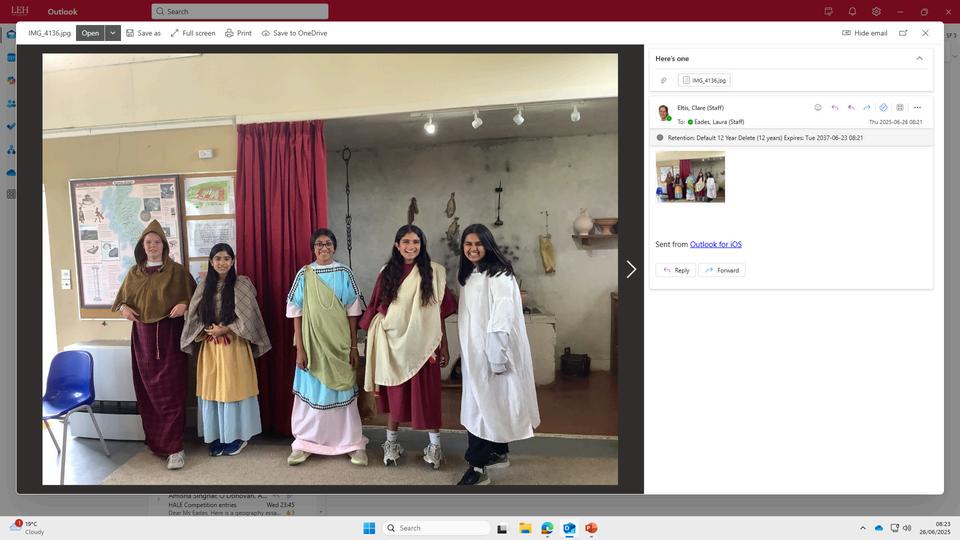

L4 Languages trip to France

Off we went on Tuesday morning, leaving the sunny warmth of England behind us! The coach driver was chuffed that we made it to Dover in good time and boarded an earlier ferry than planned. Le Touquet was a little on the grey side when we arrived but that didn’t stop many of the L4 trippers from going to the gorgeous sandy beach for a run around! Le Petit Train showed us some of the variety of houses and history of the town- including “Mad Cap” where Queen Elizabeth and Coco Chanel had both lived for a time. Wednesday brought us the joys of the “Parc Bagatelle” where we were able to go on all the rides several times as the queues were not too long. In a boulangerie on Thursday, Bruno the baker showed us how to make a proper “Pain de campagne” in his 100-year-old oven. And we all had a pain au chocolat to celebrate. Then it was a trip to Nausicaa in Boulogne in the afternoon - Europe’s biggest aquarium. As I write this we are on our way to one final treat- a miniature village in Saint Joseph before we board the ferry to go home. So much fun packed into 3 days- this has been a blast of a trip organised expertly by Mr Agulian with support from Mme Murray, Mlle Devern and Mme Rowe. Chouette!!

L6 German debate.
On Monday 23rd June, L6 Germanists from Hampton School and St John’s School Leatherhead joined us here at LEH for a L6 German debating competition. The motions to debate included a mobile phone ban for the under 16s, whether AI represents the biggest danger for future generations and if Berlin’s cultural scene could be considered to be better now than in the golden age of the 1920s.
Students showcased their excellent German language skills and even managed
i ability to think
Huge congratu done to Captain
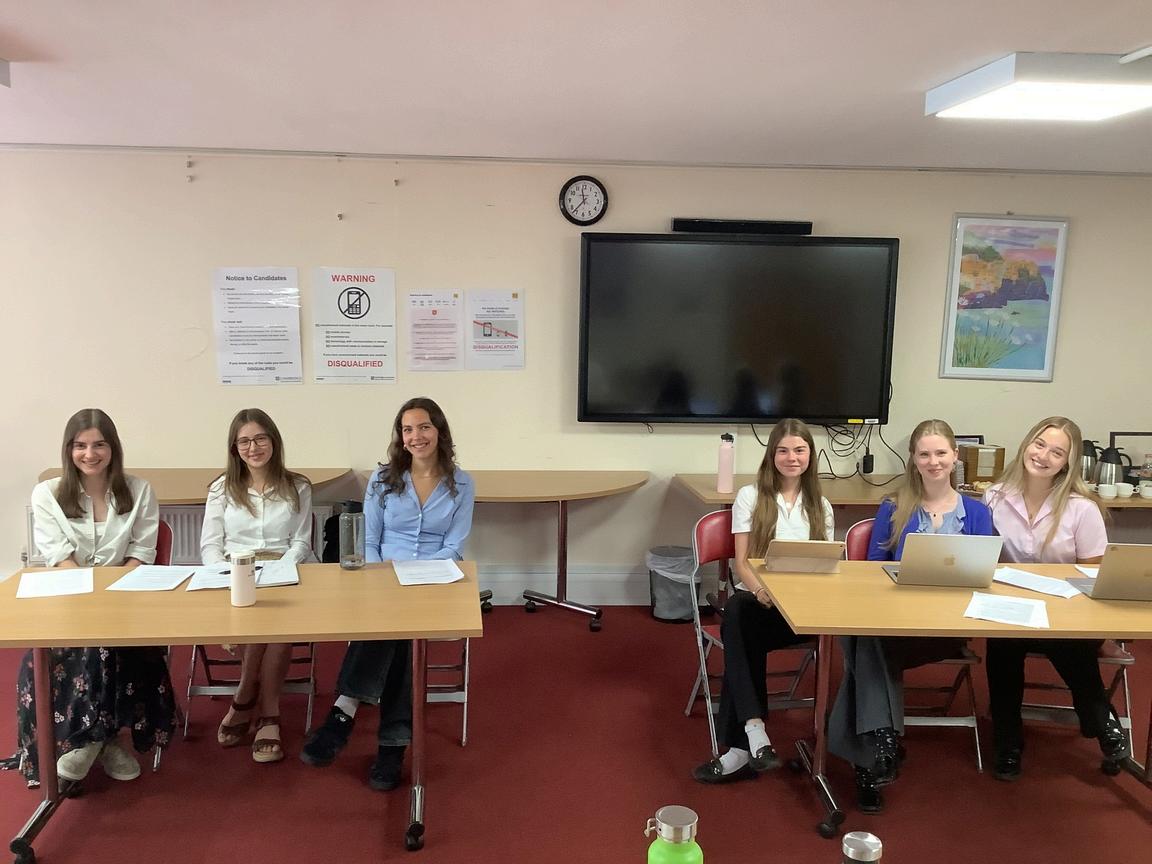
3rds Classics trip to Bignor Roman Villas
by Amna
The moment we arrived at Bignor, trudging up that hill with everyone slightly out of breath, you could feel anticipation building. Liz and Lisa emerged like friendly guides to the past, and when my group got Liz, she had this wonderful way of making two-thousand-year-old stories feel like they’d happened yesterday.
The model came first seeing the whole puzzle before diving into the pieces. But then Liz told us the discovery story, and suddenly we weren’t just tourists; we were part of an ongoing adventure. A farmer with a new plough, going just a bit deeper than usual, strikes stone. Instead of cursing and moving on like most people would, he keeps digging. His friend was obsessed with archaeology when it was barely even a real field yet. Together they unearth this incredible Roman villa that had been sleeping under Sussex soil for centuries. We were literally standing on Roman floors. Not looking at them through glass standing on the actual mosaics that Romans had walked across daily. The tesserae crunched slightly under our feet, tiny pieces of sandstone, limestone, and precious marble that someone had placed with infinite care, creating patterns that would outlast empires.
The Medusa mosaic stopped everyone cold. Here was this fierce mythological creature, snakes writhing from her scalp, eyes that could turn you to stone but Romans considered her protection. There’s something wonderfully contradictory about that: the monster as guardian, death as protector. Medusa became the ultimate security system, her terrifying gaze warning away evil while welcoming family. Standing over her, you felt both protected and slightly nervous.
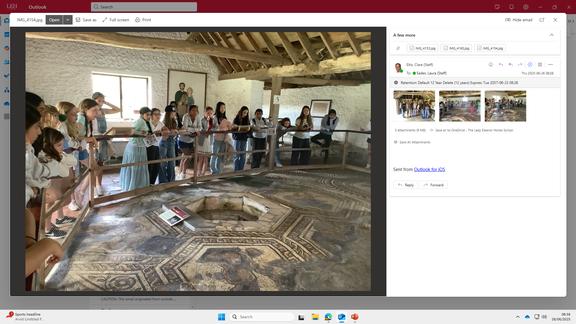

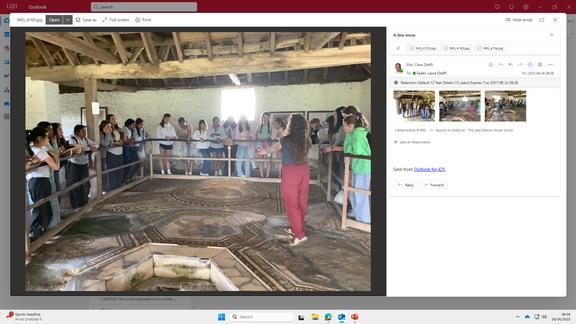
The Four Seasons mosaic was pure poetry in stone despite its crudeness spring flowers blooming into summer abundance, autumn harvests fading to winter’s rest. I was realizing that Romans living in Britain needed these reminders of Mediterranean seasons, stone promises that warmth would return even to this cold province. We were shown the hypocaust system, and suddenly we were looking at Roman central heating that put our modern systems to shame. Where the ceiling had collapsed and floor had broken, you could see into the hollow spaces underneath this incredible network of pillars and channels that turned every room into a giant radiator. The tunnel leading in told the most Roman story of all: somewhere in the darkness, a slave tended an eternal fire so that wealthy Romans could walk barefoot on warm floors in British winter. The heat rose evenly because the spacing was mathematical, precise Romans didn’t just build things, they engineered them. The chimneys let heat escape through wall cavities, warming every surface until the whole villa became a cocoon of comfort. There was something almost poetic about that eternal fire, always burning, always warming, tended by invisible hands.
The barn walls built on Roman foundations felt like the perfect metaphor for how history works each generation building on the bones of the last, unconsciously preserving what came before. Roman architects had no idea they were laying the stones for generations to come. I think that’s why it survived when so many other sites didn’t.
The cold bath was our final stop, and Liz walked us through the full Roman bathing ritual: hot bath first to open pores and loosen dirt, massage with oils, scraping everything off with those curved strigils, then the shocking plunge into cold water that left you refreshed. The hot and warm baths were smaller because heating water was expensive, but this cold plunge could be generous the final shock that completed the ritual.
By the time we walked back down that hill, everyone was quieter, thoughtful in that particular way that comes after touching something much older than yourself. We’d spent the afternoon walking through someone else’s daily life, seeing how they’d solved problems of comfort and beauty in ways that still seemed impossibly sophisticated.
L6 Easter trip to Hamburg by Ella
At the beginning of the Easter holidays, the L6 Germanists travelled to the city of Hamburg in Northern Germany, where we stayed for a week in a hostel. We attended a language school in the mornings and did work experience in the afternoons. This was a great opportunity for us to practice our German with native speakers and be fully immersed in the language. The work experience offered us the chance to learn more about a variety of German work places, such as kindergartens and toy shops. We found the Hamburg public transport to be frequent and easy to use when getting to and from our work placements. Throughout the week, we also enjoyed participating in a variety of activities and cultural events. We had a tour around the famous St Pauli football stadium, completed an escape room in German, and visited the Miniatur Wunderland, which has the largest model railway in the world. A highlight of the trip was the evening we spent at the Hamburg Dom (funfair) with rides which gave us views all over the city. We all enjoyed learning more about German culture and would really recommend the trip to next year’s L6.


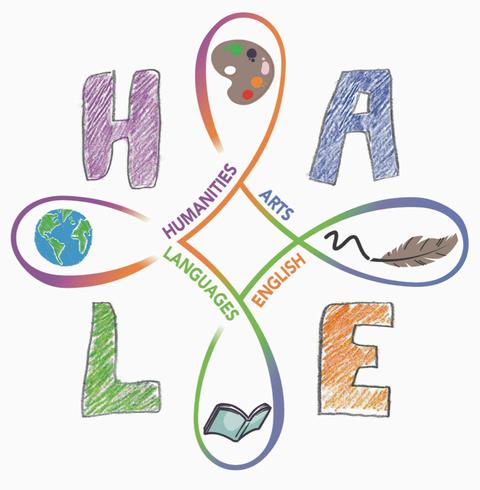
Thank you very much to all those who have submitted their competition entries. The HALE Team wish you a lovely summer break!
